![]()
![]()
![]()
Use LEFT and RIGHT arrow keys to navigate between flashcards;
Use UP and DOWN arrow keys to flip the card;
H to show hint;
A reads text to speech;
17 Cards in this Set
- Front
- Back
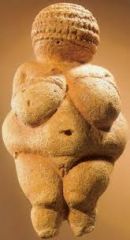
|
Nude Woman Paleolithic 28,000-25,000 BCE. Willendorf Austria Made of Limestone Idealized Image of Woman Fertility Portable-Nomadic Tribe Ball like Shapes, due to natural shape of stone |
|
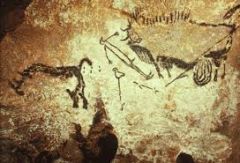
|
16,000-14,00 BCE Paleolithic Bird Headed Man with Bison, Cascaux Caves, France Narrative art Male figure displays both human and animals Hunting Scene |
|
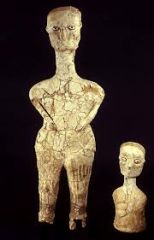
|
Human Figures from Ain Ghazel, Jordan c. 6750-6250 BCE Neolithic dozen of large white plaster statuettes mark beginning of monumental sculptures in Mesopotamia |
|
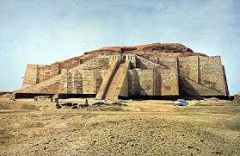
|
White Temple Ziggurat, Uruk 3200-3000 BCE oriented to the cardinal points of the compass dedicated to the sky god, Anu Only select few priests or important community leaders are allowed in several rooms central room/cella was the divinity's room |
|
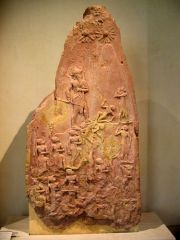
|
Victory Stele of Naram-Sin 2254-2218 BCE Mesopotamia Shows Naram-Sin leading army up mountain Appears as God scaling the ladder to heavens Suggests discipline and organization, enemies are opposite rejects standard Mesopotamian format Places figures on tiers Landscape
|
|
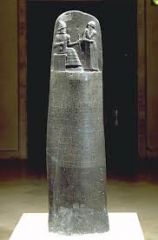
|
Stele with laws of Hammurabi 1780 BCE, Mesopotamia Set of nearly 300 laws combined fronal and side views of figures explored foreshortening -beard is in series of diagonal lines -God's throne at an angle |
|
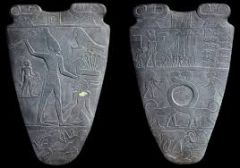
|
Pallet of King Narmer 3000-2920 BCE Predynastic/Early Dynastic Period Heirarchy of Scale Shown in composite of frontal and profile views Earliest surviving labeled works of historical art feline necks=unification Narmer wears red crown of lower Egypt Divided into registers |
|
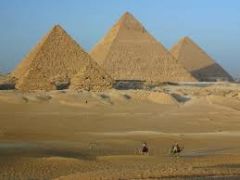
|
Great Pyramids at Giza, Fourth Dynasaty 2551-2494 BCE Old Empire Course of 75 years symbol of the sun represent the culmination of an architectural revolution Began with the Mastaba oriented to the cardinal points of the compose |
|
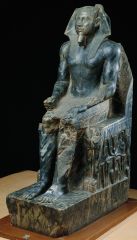
|
Khafre enthroned, from Gizeh, Fourth Dynasty 2520-2494 Old Kingdom Egypt Divine Ruler with a perfect body Rigid pose=eternal stiffness Symbolic of United Egypt Wears royal Headdress God-like Kings proclaim divine nature of Egyptian Kingship
|
|
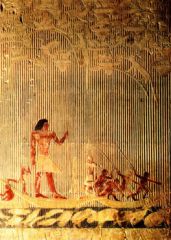
|
Ti watching Hippo Hunt, Mastaba of Ti, Fifth Dynasty Egypt, 2450-2350 Old Kingdom Metephor Triumph over Evil Men busy while King watches Combined frontal and side views On tomb wall |
|
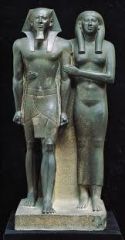
|
Menkaure and Khamerernebty, from Gizeh, Egypt 2490-2472 BCE Old Kingdom Double portrait Displays the conventional postures used for statues designed as substitute homes for the ka. frozen gestures signify the couple are married High-Relief Leg forward with no distribution of weight |
|

|
Hatshepsut with offering jars, from the upper court of her mortuary temple ca. 1473-1458 BCE New Kingdom Wears royal male nemes headress and pharaoh's ceremonial beard Anatomically male
|
|

|
Akhenaton ca. 1353-1335 BCE New Kingdom Akhenaton initiated both religious and artistic revolutions an attempt to portray the pharaoh as Aton, sexless sun disk |
|
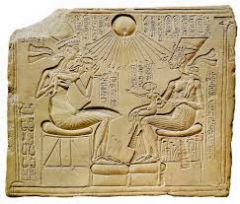
|
Akhenaton, Nefertiti, and three daughters, from Amarna, Egypt New Kingom ca. 1353-1335 BCE founded new religon honoring 1 god (sundisk) domestic setting informal
|
|

|
Palace of Knossos, Greece, ca. 1700-1370 BCE Minonan Art Knossos palace, largest on Crete was the legendary home of King Minos. It's layout features a large central court surrounded by scores of residential and administrative units. |
|
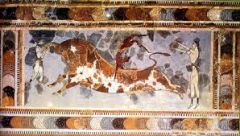
|
Bull leaping, from palace, Knossos (Crete) Greece, ca. 1400-1370 BCE Minoan Art women-fair skin long bull-form full of energy profile pose with full view eyes like egypt/mesopotamia long hair and proud living motion |
|
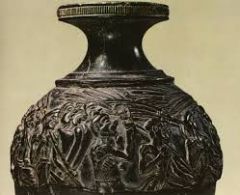
|
Harvesters Vase, Hagia Triada (Crete) Greece, ca. 1500-1450 BCE Mycenaean Art Relief Sculpto of singing harvestors Represent underlying muscular and skeletal structure of the human body combined frontal and profile views recorded tension and relation of facial muscles |

